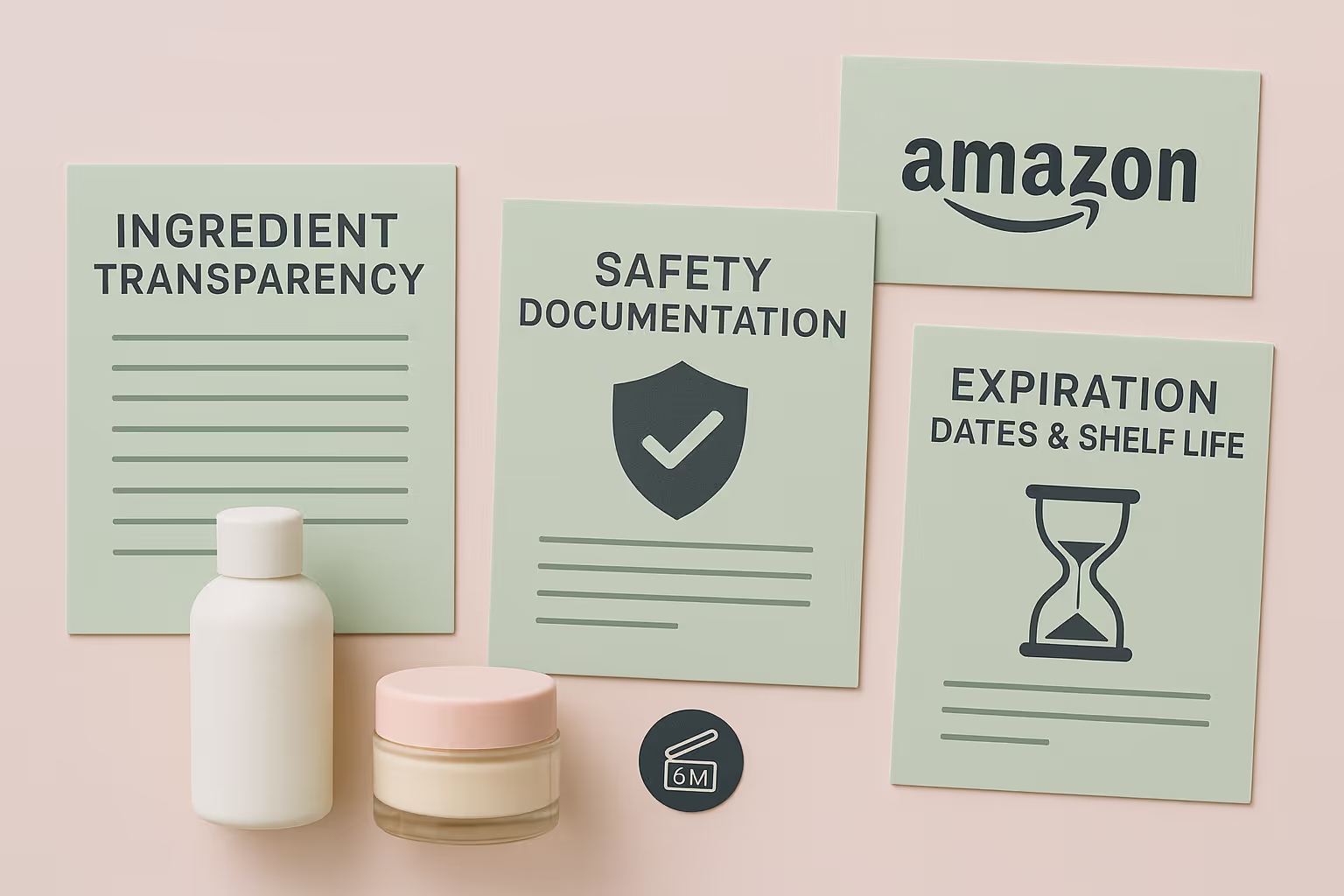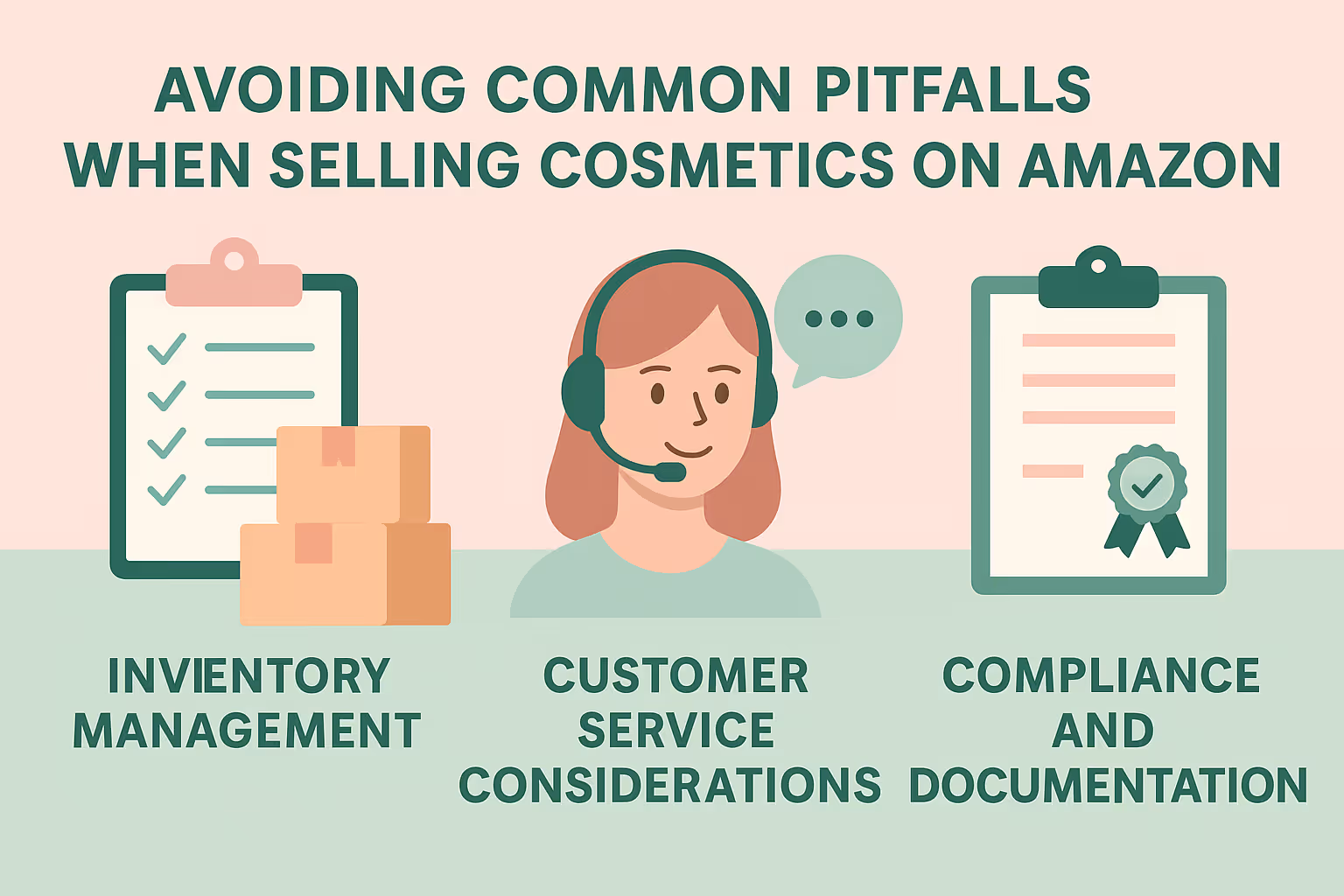
The beauty industry is booming on Amazon, with cosmetics among its top-selling categories. Amazon accounted for nearly 40% of U.S. online beauty sales in 2023.
For new and established brands, it offers massive reach and daily visibility. It's a key platform for scaling your cosmetic line.
Knowing how to sell cosmetics on Amazon is essential to succeed in this space. With the right listings, strategy, and fulfillment, your products can stand out. Tap into the world’s largest online marketplace to grow your beauty brand efficiently.
Start Selling Beauty Products on Amazon with 3 Easy Steps
Getting started with selling cosmetics on Amazon requires careful planning and following specific guidelines. The beauty category on Amazon is gated, meaning sellers need approval before listing products. Here's how to begin:
Register as an Amazon Seller
The first step is creating a seller account on Amazon. Choose between:
- Individual Seller Account: Best for those selling fewer than 40 items per month, with a fee of $0.99 per sale plus selling fees.
- Professional Seller Account: Recommended for serious cosmetics sellers at $39.99 monthly plus selling fees, but with no per-item fee.
For cosmetics businesses, the Professional account typically makes more sense due to the volume potential and additional features like bulk listing tools and advanced reporting.
Apply for Category Approval
Cosmetics fall under Amazon's "Beauty & Personal Care" category, which requires approval before listing products. To get approved:
- Log in to Seller Central
- Navigate to the "Inventory" tab
- Select "Add a Product."
- Search for a product similar to what you'll sell
- Click "Show limitations" to see requirements
- Click "Apply to sell" and follow the application process
Amazon typically requires:
- Invoices from manufacturers or distributors (not retail receipts)
- Images of product packaging and labels
- Documentation showing compliance with regulations
- Good account performance metrics if you're already selling in other categories
Meet Regulatory Requirements
Before selling cosmetics on Amazon, ensure your products comply with:
- FDA Regulations: All cosmetics must comply with FDA guidelines
- Proper Labeling: Including ingredients, net quantity, and warning statements
- Restricted Ingredients: Ensuring products don't contain prohibited substances
- Manufacturing Standards: Following Good Manufacturing Practices (GMP)
Non-compliance can result in account suspension and potential legal issues, so this step shouldn't be overlooked.
Amazon might own 40% of the online beauty market, but without the right setup, your products won’t even make it past the gate. This cheat sheet shows which seller model fits your goals and what compliance checks you can’t skip.
Creating Winning Cosmetic Product Listings
Once approved to sell in the beauty category, creating optimized product listings becomes crucial for visibility and sales.
Product Photography for Cosmetics
High-quality images are especially important for beauty products:
- Use professional, well-lit photography against a white background for main images
- Include lifestyle images showing the product in use
- Add close-ups of packaging, ingredient lists, and texture shots
- Show color variations accurately
- Consider before/after images where appropriate (while following Amazon's guidelines)
Pro tip: For foundation, lipstick, or other color-specific products, include images showing the product on different skin tones to help customers make appropriate selections.
Writing Compelling Cosmetics Descriptions
Your product descriptions should:
- Begin with a strong headline highlighting key benefits
- Include all relevant product details (volume/weight, ingredients, usage instructions)
- Use bullet points to highlight main features and benefits
- Address common customer concerns preemptively
- Include relevant keywords naturally throughout the text
For example, instead of just "Red Lipstick," describe it as "Long-lasting Matte Red Lipstick - 8-Hour Wear, Cruelty-Free Formula with Moisturizing Vitamin E."
Pricing Strategy for Beauty Products
When pricing your cosmetics on Amazon:
- Research competitor pricing thoroughly
- Consider your costs, including Amazon fees, shipping, and returns
- Think about your positioning (luxury, mid-range, or budget)
- Factor in promotional pricing strategies for launches
- Consider bundling complementary products
Navigating Amazon's Cosmetics Requirements

Amazon has specific requirements for beauty and personal care products that sellers must follow.
Ingredient Transparency
Amazon requires complete ingredient disclosure for all cosmetic products. This includes:
- Full ingredient lists follow the INCI (International Nomenclature of Cosmetic Ingredients) standards
- Proper identification of potential allergens
- Clear indication of active ingredients and their concentrations
Safety Documentation
Be prepared to provide:
- Safety Data Sheets (SDS)
- Documentation of product testing
- Certificates of Analysis (COA)
- Good Manufacturing Practice (GMP) certification
Expiration Dates and Shelf Life
All cosmetic products must display:
- Manufacturing dates
- Expiration dates
- Period After Opening (PAO) symbol indicating how long the product is safe after opening
Amazon requires products to have at least 3-6 months of shelf life remaining when received at their fulfillment centers.
FBA vs. FBM for Cosmetics Sellers
Choosing between Fulfillment by Amazon (FBA) and Fulfillment by Merchant (FBM) is a critical decision for cosmetics sellers.
Fulfillment by Amazon Benefits
With FBA, Amazon handles storage, packing, shipping, and customer service:
- Products become eligible for Prime shipping
- Higher chance of winning the Buy Box
- Amazon handles returns and customer service
- More time to focus on product development and marketing
However, FBA involves additional fees and requires meeting strict packaging and labeling requirements.
Fulfillment by Merchant Considerations
With FBM, you maintain control over inventory and shipping:
- Lower fulfillment costs for higher-priced, lower-volume products
- Direct handling of fragile items
- More control over packaging presentation
- Ability to include samples, thank you notes, or special packaging
Many successful cosmetics sellers use a hybrid approach, utilizing FBA for bestsellers and FBM for luxury, fragile, or specialized items.
For a more streamlined approach, consider fulfillment solutions specifically designed for beauty brands that understand the unique needs of cosmetic products.
Building a Cosmetics Brand on Amazon
While individual product success is important, building a recognizable brand on Amazon creates long-term value.
Amazon Brand Registry
Enrolling in Amazon Brand Registry provides several advantages:
- Better protection against counterfeiters
- Access to enhanced brand content (A+ Content)
- Access to Amazon Stores
- Brand Analytics for deeper customer insights
- Sponsored Brands advertising options
To qualify, you need a registered trademark for your brand name.
Enhanced Brand Content
A+ Content (formerly Enhanced Brand Content) allows brands to enhance product descriptions with:
- Rich text formatting
- Comparison charts
- Custom image banners
- Brand story elements
- Video content
Cosmetics brands that effectively utilize A+ Content typically see conversion rate increases of 3-10%.
Amazon Stores
Creating an Amazon Store gives your brand a dedicated space within Amazon:
- Custom URL (amazon.com/yourbrand)
- Multiple pages showcasing different product lines
- Curated content organized by categories, concerns, or collections
- Brand videos and lifestyle imagery
- Shopping guides and educational content
An Amazon Store helps establish credibility and guides customers through your full product line, increasing average order value.
Marketing Strategies for Cosmetics on Amazon
Simply listing products isn't enough in the competitive cosmetics category. Strategic marketing is essential.
Amazon PPC Advertising
Pay-Per-Click advertising is crucial for cosmetics visibility:
- Sponsored Products for individual product promotion
- Sponsored Brands to showcase your brand and multiple products
- Sponsored Display ads to reach customers on and off Amazon
Start with automatic campaigns to identify converting keywords, then create targeted manual campaigns focusing on high-performing terms.
External Traffic Strategies
Driving external traffic to your Amazon listings can boost rankings:
- Social media marketing (especially visual platforms like Instagram and TikTok)
- Influencer partnerships
- Email marketing to existing customers
- Beauty blog features and reviews
- YouTube tutorials featuring your products
External traffic not only increases sales but also improves organic ranking factors in Amazon's algorithm.
Launch Strategies for New Cosmetics
When launching new beauty products:
- Use "New Release" promotions
- Consider time-limited discount codes
- Create bundles with established bestsellers
- Implement a review acquisition strategy
- Schedule social media announcements to coincide with Amazon availability
Private Label Cosmetics Opportunities
Many successful Amazon sellers utilize private label strategies for their cosmetics lines.
Finding Reliable Manufacturers
When seeking cosmetics manufacturers:
- Research domestic and international options
- Verify regulatory compliance and certifications
- Request samples and test extensively
- Check minimum order requirements
- Evaluate customization options
Private label skincare products offer an accessible entry point for many entrepreneurs, with lower minimum order quantities than some other cosmetic categories.
Customization Options
Consider what level of customization you need:
- Stock formulations with custom packaging
- Semi-custom formulations with ingredient modifications
- Fully custom formulations developed specifically for your brand
- Custom packaging, applicators, and dispensing systems
The level of customization affects both upfront costs and profit margins.
Quality Control for Private Label Cosmetics
Maintaining consistent quality is essential:
- Establish clear quality standards in writing
- Request Certificates of Analysis for each batch
- Conduct random testing of production runs
- Develop a customer feedback system to identify issues quickly
- Create a documented quality assurance process
Remember that your brand reputation depends on product quality, regardless of who manufactures the items.
Avoiding Common Pitfalls When Selling Cosmetics on Amazon

The beauty category presents unique challenges that sellers should prepare for.
Inventory Management
Cosmetics have specific inventory concerns:
- Limited shelf life requiring careful rotation
- Seasonal variations in demand for certain products
- Color and formulation variations create complex inventory needs
- Temperature sensitivity during storage and shipping
Proper forecasting and inventory management systems are essential to avoid both stockouts and excessive aging inventory.
Customer Service Considerations
Beauty products often require specialized customer support:
- Color matching assistance
- Ingredient questions from customers with sensitivities
- Application technique guidance
- Addressing adverse reactions appropriately
- Managing expectations about results
Prompt, knowledgeable responses to customer questions can significantly reduce return rates.
Compliance and Documentation
Staying compliant requires ongoing attention:
- Keeping up with changing regulations
- Maintaining proper documentation
- Updating ingredient lists when formulations change
- Ensuring accuracy in all marketing claims
- Properly documenting batch numbers and manufacturing dates
Pro tip: Create a regulatory compliance calendar with reminders for periodic reviews of product listings, documentation updates, and certificate renewals to avoid compliance gaps that could result in listing removals.
Scaling Your Amazon Cosmetics Business
Once you've established initial success, strategic scaling can maximize your business potential.
Product Line Expansion
Thoughtful expansion strategies include:
- Expanding the color ranges of successful products
- Adding complementary products (e.g., adding lipliners to a successful lipstick line)
- Creating seasonal or limited-edition variations
- Developing solution-based collections (anti-aging, sensitive skin, etc.)
- Moving into adjacent beauty categories (skincare if you sell makeup, or vice versa)
International Expansion
Amazon's global marketplaces offer growth opportunities:
- Research regulatory requirements in target countries
- Consider cultural preferences in product formulations and marketing
- Adjust pricing strategies for different markets
- Plan for increased logistics complexity
- Prepare for translation and localization needs
Building Off-Amazon Presence
Reducing dependency on Amazon strengthens your business:
- Develop your e-commerce website
- Establish social media channels
- Build an email subscriber list
- Explore retail partnerships
- Consider subscription models for replenishable products
Veteran Seller Insight: Use Amazon's Hidden Flat File Uploads to Boost SEO Control
Experienced beauty sellers know that standard listing tools limit SEO flexibility. Instead, use Amazon’s category-specific flat file templates, accessible through Seller Central, to unlock backend keyword fields, control search terms, and fine-tune product discoverability.
For those mastering how to sell cosmetics on Amazon, this backend method enables precise targeting, hidden keyword input, and structured data optimization that most new sellers overlook. It's a technical edge that can significantly improve organic ranking and conversion.
Your Beauty Brand's Amazon Success Story Starts Now
The cosmetics category on Amazon is growing fast, offering major opportunities for brands with a strategic approach. From approvals to optimized listings and smart marketing, success requires focus and ongoing refinement.
While competition is high, brands that deliver quality, authenticity, and customer-first strategies can thrive. Amazon rewards innovation and clarity, perfect for beauty brands that stand out.
Ready to grow your brand on Amazon? Start by understanding your niche, meeting compliance standards, and crafting a clear marketing plan. With the right steps, your cosmetics line can become a beauty best-seller.
FAQ
Related blogs

Price Elasticity Of Demand Calculator: Predict Revenue Impact in Seconds

High-Low Method Calculator: Discover Your True Fixed and Variable Costs

Dynamic Pricing Calculator: Optimize Margins and Sell Smarter With Every Click


